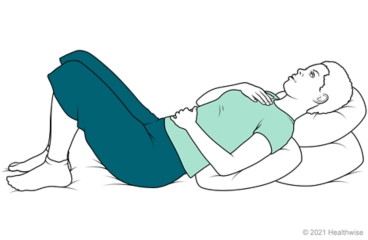Overview

Breathing is hard when you have lung problems like chronic obstructive pulmonary disease (COPD) or interstitial lung disease. You may take quick, short breaths. Breathing this way makes it harder to get air into your lungs. Learning new ways to slow down and control your breathing may help. You may feel better and be able to do more because you can breathe better.
You can try two ways to control your breathing. They are pursed-lip breathing and diaphragmatic breathing (belly breathing).
Use these methods when you are more short of breath than normal. Practice them often so you can use them correctly when you need to.
Follow-up care is a key part of your treatment and safety. Be sure to make and go to all appointments, and call your doctor if you are having problems. It's also a good idea to know your test results and keep a list of the medicines you take.
How can you care for yourself at home?
- Practice pursed-lip breathing and diaphragmatic breathing (belly breathing) daily. Try to do them 3 or 4 times a day. Plan to do each exercise for about 10 minutes each time. Once you know how to do these breathing techniques, you can use them when you are short of breath to help you get relief.
- Pursed-lip breathing helps you breathe more air out so that your next breath can be deeper. Pursed-lip breathing can relieve shortness of breath and help you be able to move around. Think of it as "smell the flowers (inhale) and blow out the candle (exhale)."
- Breathe in through your nose for about 2 seconds.
- Breathe out through your mouth while almost closing your lips for 4 to 6 seconds. Note that exhaling is longer than inhaling.
- Belly breathing helps your lungs expand so that they take in more air. It also helps strengthen your diaphragm. Your diaphragm is a large muscle that separates your lungs from your belly. It helps draw air into your lungs as you breathe.
- Lie on your back, or prop yourself up on several pillows. You can also sit in a chair.
- Put one hand on your belly and the other on your chest. Breathe in through your nose. Let your breath push your belly out as far as possible. You should feel the hand on your belly move out, while the hand on your chest does not move.
- Breathe out through pursed lips. You should feel the hand on your belly move in.
- When you can do this type of breathing well while lying down or leaning on pillows, learn to do it while sitting or standing.
Breathing while bending forward at the waist may make breathing easier. It can reduce shortness of breath. It helps the diaphragm move more easily. Make sure to hold on to something sturdy like a countertop or chair if you're standing.
When should you call for help?
Call your doctor now or seek immediate medical care if:
- You have chest pain.
- You cough up blood.
- You have swelling in your belly and legs.
- Your shortness of breath gets worse.
- Your breathing methods do not help.
Watch closely for changes in your health, and be sure to contact your doctor if you have any problems.
Current as of: September 29, 2025
Author: Ignite Healthwise, LLC Staff
Clinical Review Board
All Ignite Healthwise, LLC education is reviewed by a team that includes physicians, nurses, advanced practitioners, registered dieticians, and other healthcare professionals.

